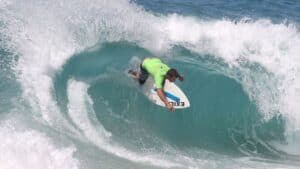Where, when and how was skimboarding invented?
The Hawaiians, Polynesians and other island cultures are suspected to have been doing some form of skimboarding for hundreds, maybe thousands of years, but we have little documentation regarding this.
So, let’s start from what we know and have documentation of. The sport of skimboarding has its US mainland origins around 1920, in California, when a couple of Laguna Beach lifeguards – George Griffeth and friend Jimmy – built rounded disks made from redwood and used them to slide across the water.
“It was two planks of redwood, connected by three strips of oak held on by small machine screws and square nuts recessed into the wood. They were about five-foot long, with no curve at all, and they were towed behind a boat much like a wakeboard,” Tex Haines, co-founder of Victoria Skimboards, once wrote.
The truth is that the “pizza board” became the standard shape for skimboarding until the early 1960s when a new design appeared and mimicked a smaller, wide surfboard.
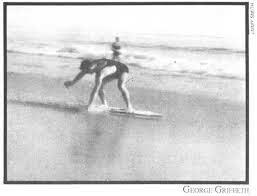
“Locals in Laguna took the traditional round boards and stretched them out into ovals to carve off the waves that break right on the shore better. That was the beginning of the skimboarding renaissance. I came along when this was well under way, at about age 11,” notes the skim pioneer.
Haines says that, at the time, the activity was called “skidboarding,” but when he and his partner started Victoria Skimboards in 1976, “we changed it to skimboarding.”
Wave and Land
As the sport gained traction, two disciplines arose: wave skimboarding and flatland skimboarding.
Initially, skimboards were seen as a fantastic alternative to flat surfing days, high tides, and pounding shore breaks but, as time went by, the sport gained full respect as a member of the water sports club.
The first annual World Skimboard Championships were held in 1976 at Aliso Beach. From that moment on, skimboarding was no longer a cool surf craft for the summer holidays.
In 1980, Tex Haines and Peter Prietto, from Victoria Skimboards, introduced the first foam core skimboards covered in fiberglass and resin, and a new chapter began for the young sport. Suddenly, skimboards were found alongside surfboards in high-end surf shops.
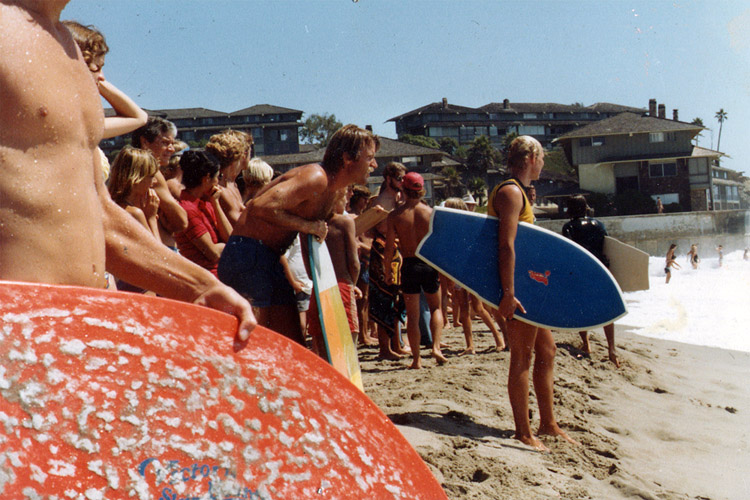
1980 Tex Haines Victoria Beach
Any flooded area are a possible skimboarding destination!
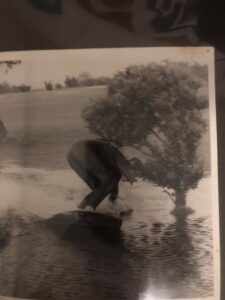
Brad Dickey bottom turning under a young pine tree at the naval golf course in Los Alamitos, Ca Surfer Mag 1983
In September 1987, Tom Trager is featured on the cover of Sports Illustrated riding a skimboard but, in the following decade, the sport would enter a dark phase – kiteboarding explodes, surfing becomes TV-friendly, and skimboard sales decline.
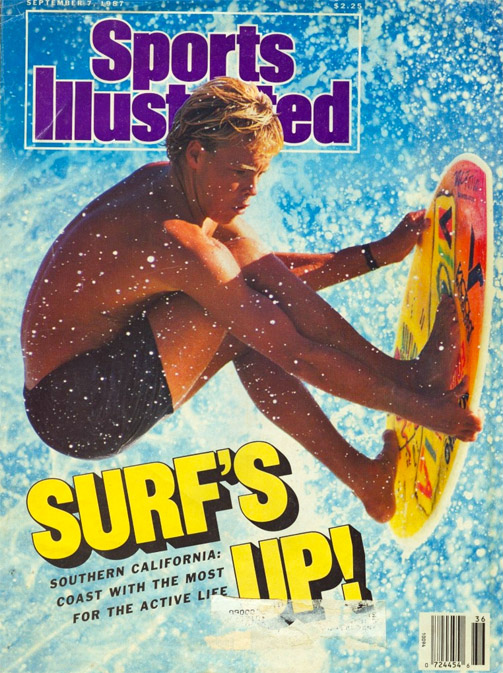
Fortunately, after the storm comes the rainbow and, soon after, new magazines and competition start to emerge and skimming regains fans and new participants.
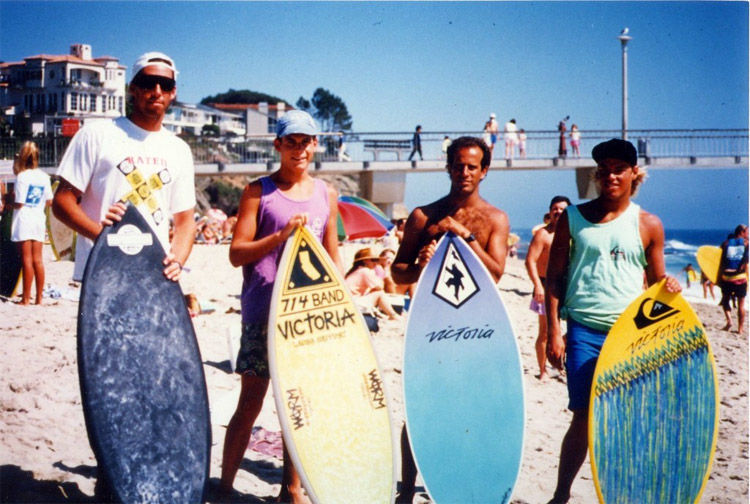
Brad Dickey, Garth Wyckoff, Chris Henderson and Tom Trager
1990 Aliso Beach Skimfest Pro Final
Skimboarding is the only water board sport that doesn’t rely on waves or wind conditions to be practiced. Riders only need a plank, a shallow water area, and a few wake-style obstacles for intermediate and advanced moves.
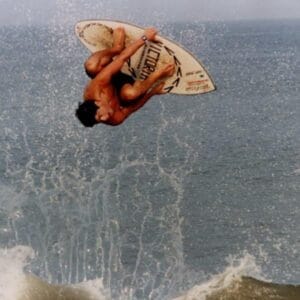
Inland skimming starts to emerge as well. Small skimboarding communities started practicing in rivers, lakes, ponds, and even in the heart of cities. There are several contest being held across the world. Freestyle skimboarding or inland/flat water skimboarding contest are now a norm.
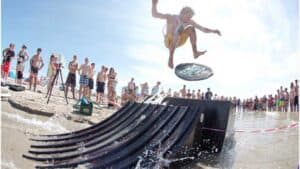
In less than three decades, the skimboarding movement spread to the Philippines, Canada, Europe, Mexico and Brazil where it has become very popular. In 2019 Skimboarding named it’s first non-US competitor as the Skimboarding World Champion, Lucas Fink from Brazil.
The Tech Transformation
Skimboarding in the 90’s becomes a tech revolution from video cameras to performing moves on a skimboard that had only previously been performed on skateboards. Leading this revolution is The 10th Street Bros. Bill and George Bryan who took the sport by storm with their innovative approach to skimboarding being acknowledge for creating the shuv-it into main stream competition and eventually developing into one of the most common tricks executed in competitions today. Their commitment to producing entertaining content that show cased skimboarding and their life style. Their progress approach to documenting skimboarding is comparable to today’s social media channels. Both Bill and George are the stepping stones to modern day skimboarding. Having a huge impact on the sport and future generation, offering a digital skimboarding playbook to build off from.
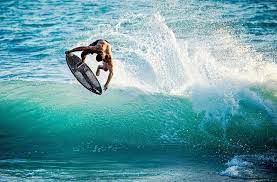
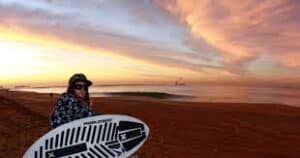
A Growing Scene
Skimboarding’s ever growing popularity can also be explained by how easy it is to start riding, and to the fact that skimboards require little maintenance.
Today, skimboarding is profoundly influenced by surfing and skateboarding, but its finless DNA has also been inspiring surfers in their retro and new-school tricks maneuvers and overall wave riding.
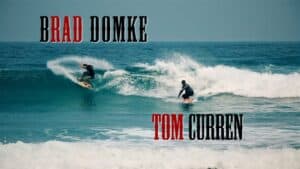
3 x World Surfing Champion Tom Curren has his own signature Pro Model Skimboard. Acknowledging that finless board wave riding is one of the purest forms of wave riding.
Today, skimboards are technologically sophisticated and combine advanced elements from the aerospace industry with the knowledge of experienced craftsmen. Three companies – Victoria Skimboards, Exile Skimboards, and Zap Skimboards – share a large majority of the sport’s market.
Skimboarding combines athletics and water sports in a particular and intelligent manner. If you’re a good surfer, it doesn’t mean you will be good skimboarder.
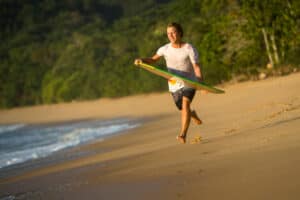
Lucas Fink 2019 Skimboarding World Champion is a product of the evolution of the sport, a great athlete, extremely technical and well versed in wave riding.
Skimboarding ability to evolve, morph and renew itself is the real story for the last 45 plus years! From the beginning of incorporating the sand slides to 360’s, to the water carving maneuvers that mimic surfing, to utilizing the freedom of disconnecting board from rider, that allows the rider to release all contact from the board for tech maneuvers similar to skating.
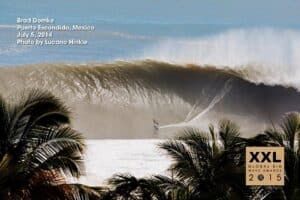
In 2014 XXL Billabong Big Wave Challenge Brad Domke took the sport to a new level. Brad was recognized as riding one the largest waves of the year in 2014 and the largest wave in the history of skimboarding.
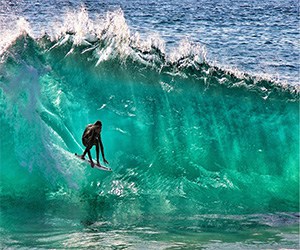
Austin Keen has had a significant impacted on the sport as well as being a Skimboarding World Champion his social media following is over 450K followers that on any given day might get access to view Austin performing stunts like “Free Skimming” behind a boat but utilizing a wooden table as a skimboard or skimming from shore to reach a boats wake that he then merges with to “Wake Skimming” or transferring one boat tow to “sling shooting himself” another boats wake to again start “Wake Skimming” seamlessly
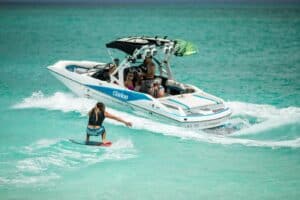
The Crossover Revolution Here
A crossover board rider lives to chase artistic, creative and entertaining content that fuels their passion, playfulness and free spirit, but still supports their roots. The new skim, surf, wake, snow and skate men & women of today all have a specialty in one of these verticals. History is being written as we create this article regarding this new era in skimboarding. More to come…..

